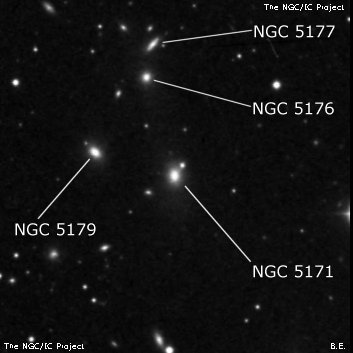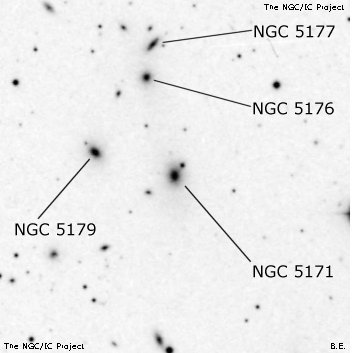NGC/IC Project Restoration Effort
(This is a very very beta version)
NGC5171


Basic Information
Location and Magnitude
Right Ascension: 13:29:21.6
Declination: +11:44:7
Constellation: VIR
Visual Magnitude: 12.8
Historic Information
Discoverer: Hough
Year of discovery: 1883
Discovery aperture: 18.5
Observational
Summary description: pB, L
Sub-type: E-S0
Corwin's Notes
=====
NGC 5171 is the brightest galaxy in a curious group. "Curious" because, of
the five NGC objects (N5171, N5176, N5177, N5178, and N5179) in it, only four
were seen by any one observer. However, since at least two of the three
observers were looking for Comet d'Arrest, they clearly picked up the nebulae
as afterthoughts.
First to go through the group was Hough, then directory of Dearborn
Observatory in Chicago, and Burnham, apparently observing with Hough the night
of 5 May 1883 on the 18.5-inch refractor. Though the positions are not
particularly good, Burnham's offsets to the 8th magnitude star 21 seconds
preceding and 58 arcsec south, pins down the nebula he saw as NGC 5171.
Dreyer creditted Burnham with the co-discovery of NGC 5179, apparently because
of the uncertain position.
Hough is credited with NGC 5171, but he describes his object as "Double.
Nebula, round, condensed." This could apply to NGC 5171 and its superposed
compact companion or star, but it could also apply to NGC 5176 and NGC 5177
which are 2-3 arcmin north-northeast of NGC 5171. Hough's position is not
good enough to tell. It also seems odd that he would record the same nebula
as new as Burnham, especially given that they were observing on the same night
with the same telescope.
On 11 May of the same year, Tempel saw NGC 5171, N5178, and N5179 with the
10.5-inch Amici I refractor at Arcetri. He has micrometric positions for the
first two, but the third was apparently too far from his comparison star to be
measured. Nevertheless, his estimated position for it is good enough to
positively identify the galaxy.
Finally, on 29 June 1883, Ernst Hartwig, using the 18-inch refractor at
Strassburg found and measured four nebulae in the group: N5171, N5176, N5177,
and N5179. His positions are very good.
So, the observers using the larger telescopes failed to find the faintest of
the nebulae, N5178. But it is the southern-most of the five, and has a lower
average surface brightness, so may not draw attention to itself as readily as
the northern four.
Steve's Notes
=====
NGC 5171
17.5" (5/27/95): faint, small, round, very small brighter core, faint 40" halo. A faint star is superimposed NW of the core. Forms the NE vertex of a right triangle with two mag 9 stars are 5.3' WSW and 6.8' SW. Brightest of five in a tight group (MKW 11) with NGC 5176 2.9' N, NGC 5177 3.8' N, NGC 5179 2.4' ENE and NGC 5178 7' SSE.



